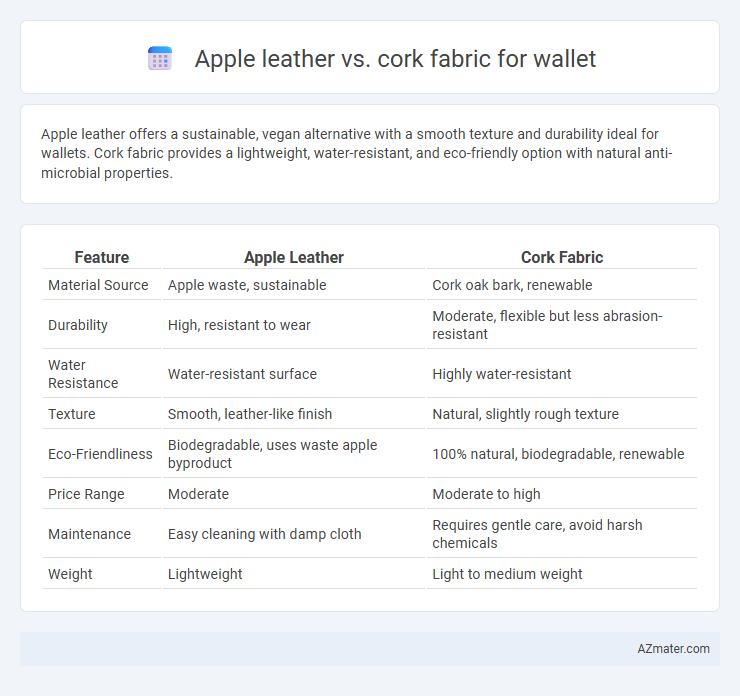Apple leather offers a sustainable, vegan alternative with a smooth texture and durability ideal for wallets. Cork fabric provides a lightweight, water-resistant, and eco-friendly option with natural anti-microbial properties.
Table of Comparison
| Feature | Apple Leather | Cork Fabric |
|---|---|---|
| Material Source | Apple waste, sustainable | Cork oak bark, renewable |
| Durability | High, resistant to wear | Moderate, flexible but less abrasion-resistant |
| Water Resistance | Water-resistant surface | Highly water-resistant |
| Texture | Smooth, leather-like finish | Natural, slightly rough texture |
| Eco-Friendliness | Biodegradable, uses waste apple byproduct | 100% natural, biodegradable, renewable |
| Price Range | Moderate | Moderate to high |
| Maintenance | Easy cleaning with damp cloth | Requires gentle care, avoid harsh chemicals |
| Weight | Lightweight | Light to medium weight |
Introduction: Eco-Friendly Alternatives for Wallets
Apple leather and cork fabric represent innovative, eco-friendly alternatives for wallet materials, reducing reliance on traditional animal leathers and synthetic fabrics. Apple leather, derived from apple pomace and waste from juice production, offers a durable, vegan option with a soft texture and natural breathability. Cork fabric, harvested sustainably from cork oak trees without harm, provides lightweight, water-resistant properties and a unique, natural aesthetic, making both materials ideal choices for environmentally conscious wallet designs.
Material Origins: Apple Leather vs Cork Fabric
Apple leather is derived from the waste of the apple juice and compote industry, utilizing crushed apple peels and cores combined with a polyurethane binder to create a sustainable, vegan alternative to traditional leather. Cork fabric originates from the bark of the cork oak tree, harvested without felling the tree, making it a renewable resource with natural water resistance and breathability. Both materials offer eco-friendly options, but apple leather relies on fruit waste repurposing, while cork fabric is a naturally harvested plant material requiring minimal processing.
Sustainability and Environmental Impact
Apple leather, made from apple waste, offers a biodegradable and low-impact alternative to traditional leather, reducing reliance on animal agriculture and minimizing landfill waste. Cork fabric, harvested from the bark of cork oak trees without harming the tree, supports biodiversity, carbon sequestration, and has a long lifespan with natural water resistance. Both materials provide eco-friendly options for wallets, with apple leather excelling in biodegradable disposal and cork fabric enhancing forest conservation efforts.
Durability and Longevity Comparison
Apple leather offers moderate durability with natural elasticity, resisting wear and tear better than some synthetic materials, while cork fabric excels in water resistance and scratch resistance due to its unique cellular structure. Cork fabric, derived from the bark of cork oak trees, provides exceptional longevity by remaining flexible and maintaining integrity over time without cracking. Both materials present eco-friendly options, but cork fabric often surpasses apple leather in long-term resilience for wallets exposed to frequent handling and environmental factors.
Texture and Aesthetic Appeal
Apple leather offers a smooth, supple texture with a subtle natural grain that mimics traditional leather, providing a sleek and modern aesthetic ideal for minimalist wallets. Cork fabric features a distinctive, slightly rough texture with unique veining patterns, lending wallets a rustic, eco-friendly appearance that emphasizes natural beauty and sustainability. Both materials enhance wallet aesthetics but cater to different style preferences, with apple leather favoring a polished look and cork fabric delivering organic charm.
Comfort and Usability Factors
Apple leather offers a soft, supple texture that conforms comfortably to the hand, enhancing user experience through its lightweight and breathable quality. Cork fabric provides a unique, natural softness combined with water resistance, making it durable and easy to maintain for daily wallet use. Both materials excel in flexibility, but apple leather's smooth finish caters more to long-term comfort, while cork fabric stands out for eco-friendly usability and resilience.
Maintenance and Care Tips
Apple leather wallets require gentle cleaning with a damp cloth and mild soap to maintain their smooth texture, avoiding harsh chemicals that can degrade the material. Cork fabric wallets benefit from water-resistant properties, needing only occasional wiping to remove dirt and should be kept away from prolonged sunlight exposure to prevent discoloration. Both materials thrive with proper storage in cool, dry places and regular conditioning specific to their composition to extend wallet lifespan.
Price and Market Availability
Apple leather wallets typically range from $50 to $150, reflecting their emerging status and eco-friendly appeal in the market, while cork fabric wallets usually cost between $40 and $100, offering a more affordable and widely available sustainable option. Apple leather is gaining traction but remains less accessible globally compared to cork fabric, which is sourced from cork oak trees predominantly in Portugal and has established distribution channels. The durability and unique texture of cork fabric contribute to its sustained popularity among budget-conscious consumers seeking eco-friendly wallet alternatives.
Pros and Cons: Apple Leather and Cork Fabric
Apple leather offers a sustainable alternative to traditional leather with a smooth texture, durability, and water resistance, but it may have a higher price point and occasional breathability issues. Cork fabric is lightweight, naturally antimicrobial, and highly renewable, making it eco-friendly and moisture-resistant, though it can be less flexible and prone to wear over time. Both materials provide vegan options for wallets, with apple leather excelling in aesthetic similarity to genuine leather and cork fabric standing out for its unique natural pattern and environmental benefits.
Conclusion: Which is Better for Your Wallet?
Apple leather offers a smooth texture, durability, and eco-friendly attributes, making it an excellent choice for sustainable wallets. Cork fabric is lightweight, water-resistant, and naturally antimicrobial, ideal for those seeking a unique, vegan material with a distinct look. For long-lasting, stylish wallets with minimal environmental impact, apple leather tends to outperform cork fabric, but personal preferences regarding texture and appearance will influence the final choice.

Infographic: Apple leather vs Cork fabric for Wallet
 azmater.com
azmater.com